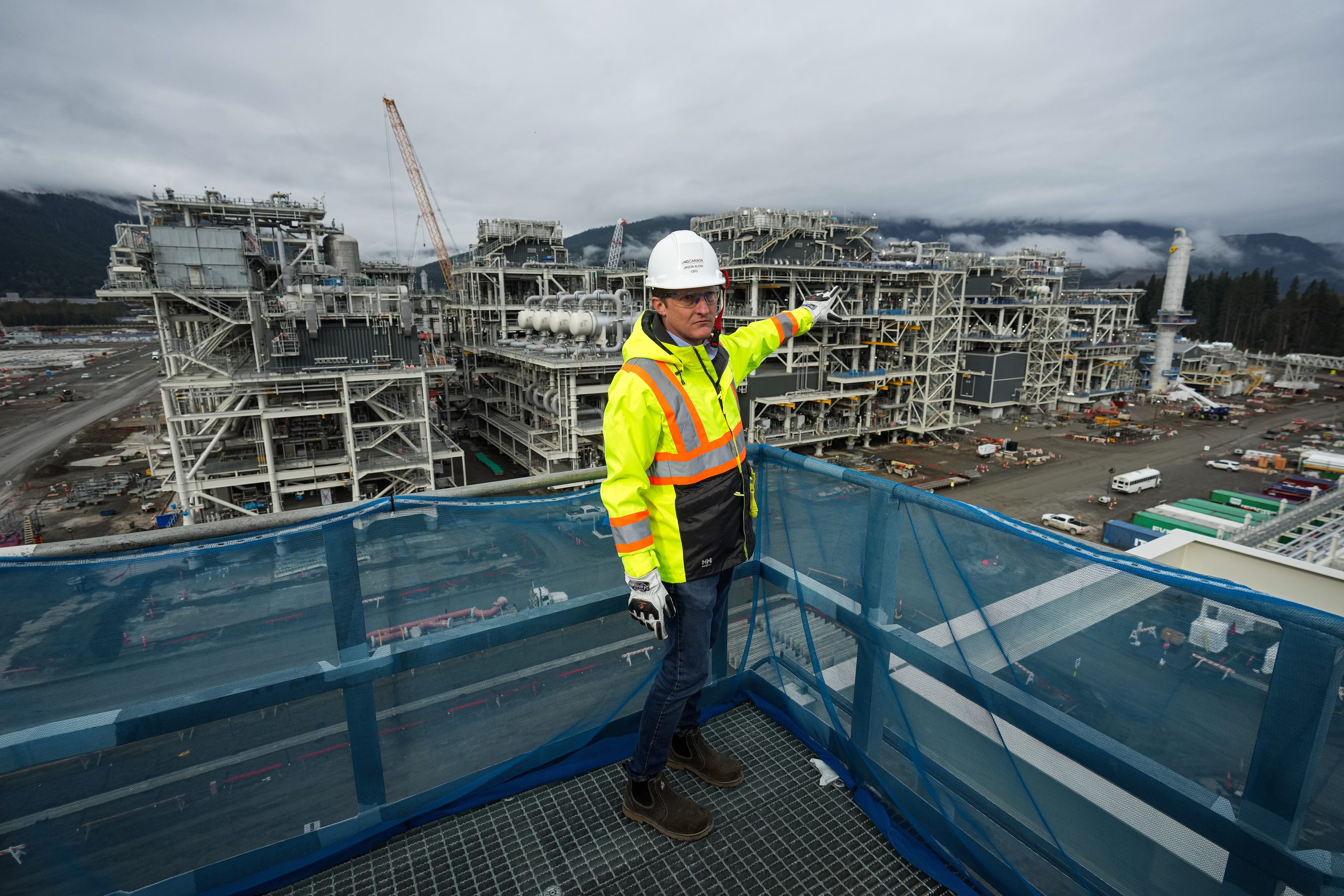Anti-oil and gas activists are demanding Canadian institutions and investors stop all funding support for Canadian oil and gas.
They say oil and gas are not needed in the future if there is a “renewable energy revolution.” But they are wrong. Even in the most aggressive decarbonization scenarios – trajectories the world is not on – significant amounts of oil and gas will continue to be required through 2050.
“The energy future must be secure and affordable, as well as sustainable,” Daniel Yergin, Pulitzer Prize winning author and vice-chairman of S&P Global, said earlier this year.
Canadian energy is all three of those things and should not be cut off from the world.
Here are the facts.

Aerial view of Mumbai, India. According to the UN, India is now the world’s most populous country and along with China will drive the world’s population to increase by two billion people over the next three decades. Getty Images photo
Fact: The world needs responsibly produced oil and gas
While activists like to trumpet the narrative that the world is rapidly transitioning away from fossil fuels, the reality is that oil and gas will be around for a long, long time.
As more renewable and alternative energy sources become technically and economically feasible at a large scale, on the current trajectory the International Energy Agency (IEA) projects that oil and gas will still supply 46 per cent of world energy needs in 2050. That’s down only modestly from 53 per cent in 2022.
Even in the IEA’s unlikely net zero scenario – which would require unprecedented global cooperation and includes more than a third of emissions reductions coming from technologies that do not yet exist – oil and gas still account for 14 per cent of world energy supply in 2050.
Oil demand for non-energy use (like pavement, which improves in quality when using oil from Canada) even continues to increase in the IEA’s net zero scenario, rising to 6 per cent of world energy use in 2050, from five per cent in 2022.
Shutting off Canada’s ability to supply oil and gas would have no impact on how much is used around the world – or how much emissions that use generates.
It would only shift supply to our biggest competitor – the United States – or regions that are less responsible actors in areas like social progress, environmental protection and worker safety.
Fact: Canadian natural gas can reduce global emissions

LNG Canada CEO Jason Klein stands atop a receiving platform overlooking LNG processing units called trains that are used to convert natural gas into liquefied natural gas at the LNG Canada export terminal under construction, in Kitimat, B.C., on Wednesday, September 28, 2022. CP Images photo
Climate change is a global issue, so solutions should be global in nature.
For example, switching from coal to natural gas to generate power reduces emissions by 50 per cent on average, according to the IEA. Supply from Canada – exported globally as liquefied natural gas (LNG) can do even better, reducing emissions by about 65 per cent compared to coal, according to Energy for a Secure Future.
Analysts expect world LNG demand to double over the next two decades as growing Asian economies look to get off coal. LNG is now also seen a core energy supply source for Europe following Russia’s invasion of Ukraine.
Thanks to a colder climate, lower methane emissions from natural gas production, and the use of hydroelectricity to power facilities in B.C., Canada’s LNG will have some of the lowest emissions in the world.
A 2022 study by Wood Mackenzie found that Canadian LNG exports could reduce net emissions in Asia by 188 million tonnes per year through 2050. That’s the annual equivalent of removing nearly three times B.C.’s total emissions, or getting rid of all internal combustion engine cars from Canadian roads.
If Canada shuts down its ability to supply the world with LNG, it will not change demand. The demand will just be met by other countries like the United States, Qatar and Australia.
Fact: Canada’s oil sands industry has a credible path to net zero
Six companies representing 95 per cent of Canada’s oil sands production are working together with the goal of net zero emissions in their operations by 2050. This is important as most of Canada’s oil production comes from the oil sands sector.
The anchor project of the group’s target to reduce emissions by 22 million tonnes by 2030 on the way to net zero by 2050 is carbon capture and storage (CCS) technology.
According to international bodies including the IEA and the United Nations Intergovernmental Panel on Climate Change, dramatic expansion of CCS operations around the world is vital to achieve climate targets.
Canada is already a leader in the technology, with five of the world’s 30 commercial CCS facilities. This accounts for about 15 per cent of global CCS capacity even though Canada generates less than two per cent of global CO2 emissions.
Canada’s CCS operations are working. Since 2000, CCS projects in Saskatchewan and Alberta have removed more than 47 million tonnes of emissions, or the equivalent of taking more than 10 million cars off the road.
Emissions in Canada’s “conventional” (non-oil sands) oil sector are already going down. According to Environment and Climate Change Canada’s latest report to the United Nations, emissions from conventional oil production were 26 megatonnes in 2021, down from 34 megatonnes in 2019.
The world will need oil for decades to come. Supply from Canada, where producers are committed to emissions reduction, is better for the planet than supply from other countries that do not share the same commitment to innovation.
Fact: Oil and gas benefits Canadians
Shutting down Canada’s oil and gas industry would rob Canadians of huge economic activity and opportunity for economic reconciliation with Indigenous communities.
According to the federal government, oil and gas supported nearly 600,000 jobs across Canada in 2020. This includes 178,500 “direct” jobs with oil and gas companies and 415,000 “indirect” jobs in supporting industries like engineering and manufacturing.
In addition to the concentration of jobs in oil and gas producing provinces, there are thousands of jobs in manufacturing, environmental, and financial services tied to the oil and gas industry, especially in Ontario and Quebec.
In 2020, the oil and gas industry generated $118 billion in GDP. Canada’s total GDP in 2020 was $1.65 trillion, indicating that the oil and gas sector accounted for about 7.2 per cent of the country’s economic activity.
At the same time, Canada exported $86 billion worth of oil and gas in 2020, or 16 per cent of the country’s total exports. Of those shipments, 95 per cent went to the U.S.
Together, Canada’s oil sands and natural gas sectors are expected to contribute more than $640 billion to government revenues through 2050, according to CEC research. This helps pay for services like roads, schools and hospitals.
These economic benefits would evaporate without Canadian oil and gas production.
Fact: Canadian oil and gas projects benefit Indigenous communities

Haisla Nation Chief Councillor Crystal Smith celebrates HaiSea Marine’s new tugboat fleet in Istanbul, Turkiye. Photo courtesy HaiSea Marine
Indigenous businesses and communities are becoming increasingly important players in Canadian oil and gas, and that’s good for Canada and the world.
“When Europeans, Asians and Americans think of Canada’s Indigenous peoples, they often think we oppose all energy development. We aren’t victims of development. Increasingly we are partners and even owners in major projects,” Haisla Nation Chief Councillor Crystal Smith said during a press conference in April.
The Haisla Nation is 50 per cent owner of the proposed Cedar LNG project, which would be the first Indigenous-owned LNG terminal in the world. The Haisla Nation views it as an opportunity to take ownership of industrial development on their lands and to use revenues to support local social, educational and health programs.
It’s just one example of the growing role of Indigenous communities in Canadian energy.
Indigenous communities will have a stake in the LNG Canada project development as well, with 16 communities to acquire a 10% stake in the Coastal GasLink pipeline once complete in 2023.
In Alberta, 23 First Nation and Métis communities are now approximately 12 per cent owners of seven operating Enbridge oil sands pipelines, the largest Indigenous energy transaction ever in North America.
Since 2014, Indigenous employment in Canada’s oil and gas sector has increased by more than 20 per cent, reaching an estimated 10,400 jobs in 2020, according to the federal government.
Together, three projects – the Trans Mountain Expansion, Coastal GasLink, and LNG Canada – have spent approximately $9 billion with Indigenous-owned and local businesses.
Phasing out Canada’s oil and gas industry would remove these opportunities from Indigenous communities.
Fact: Engagement with oil and gas companies, not divestment, is viewed as the better choice
Heavy hitters like the Canada Pension Plan Investment Board have no interest in blanket divesting from oil and gas companies.
According to CEO John Graham, the critical task of reducing global emissions will require the skills of people inside these companies.
“If the goal is to actually remove carbon from the economy, then selling doesn’t achieve that. All selling does is sell to someone else who may not share the same values [and] may not have the same objective,” he has said.
“We continue to invest in oil and gas with a view that here we have a sector that understands energy; that understands how to get energy into people’s hands. Our view is to be an engaged owner/investor within the companies we invest in and express our expectation of a path towards net zero.”
It’s a view shared by Larry Fink, influential CEO of BlackRock Inc., the world’s largest asset management firm.
“Nothing’s more greenwashing than divestiture, because it doesn’t change the footprint of the world,” Fink said in November 2021.
“We’re not going to get to this decarbonized world that we wish if we don’t invest in technologies and industry that rapidly change our carbonized world to a more decarbonized world. But it’s a lot more complex than just having a bunch of investors moving out of some hydrocarbon companies.”
Now – and on the long-term road to a carbon neutral future – the world needs more Canadian oil and gas, not less.
The unaltered reproduction of this content is free of charge with attribution to Canadian Energy Centre Ltd.



